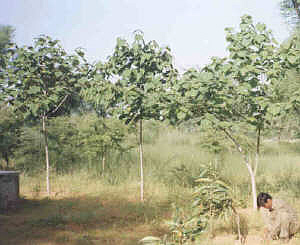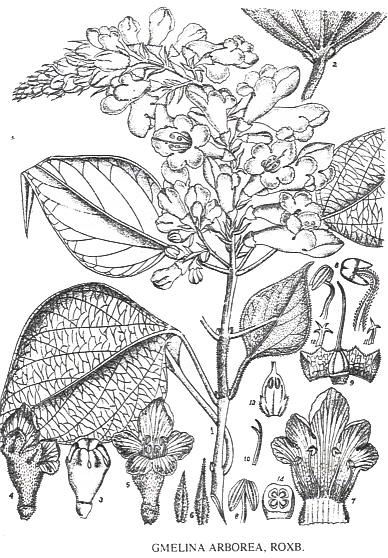

Zitierweise / cite as:
Carakasaṃhitā: Ausgewählte Texte aus der Carakasaṃhitā / übersetzt und erläutert von Alois Payer <1944 - >. -- Anhang A: Pflanzenbeschreibungen. -- Gmelina arborea Roxb. -- Fassung vom 2007-07-27. -- URL: http://www.payer.de/ayurveda/pflanzen/gmelina_arborea.htm
Erstmals publiziert: 2007-07-27
Überarbeitungen:
Anlass: Lehrveranstaltung SS 2007
©opyright: Dieser Text steht der Allgemeinheit zur Verfügung. Eine Verwertung in Publikationen, die über übliche Zitate hinausgeht, bedarf der ausdrücklichen Genehmigung des Verfassers
Dieser Text ist Teil der Abteilung Sanskrit von Tüpfli's Global Village Library
Falls Sie die diakritischen Zeichen nicht dargestellt bekommen, installieren Sie eine Schrift mit Diakritika wie z.B. Tahoma.
Verwendete und zitierte Werke siehe: http://www.payer.de/ayurveda/caraka0001.htm

Abb.: Gmelina arborea Roxb.
[Bildquelle. Wikipedia]

Abb.: Gmelina arborea Roxb.
[Bildquelle: Kirtikar-Basu, ©1918]
Drury:
"Gmelina arborea (Roxb.) N. O. Verbenaceae. Cumbulu, Mal. Joogani-chookur, Hind. Gumbaree, Beng. Tagoomooda, Tam. Goomadee, Tel.
Description.—Arboreous, unarmed; branchlets and young leaves covered with a greyish powdery tomentum; leaves long-petioled, cordate or somewhat produced and acute at the base, acuminate, the adult ones glabrous above, greyish tomentose beneath, with 2-4 glands at the base ; panicles tomentose, axillary, and terminal; raceme-like cymules decussate, trichotomous, few-flowered; bracts lanceolate, deciduous; the acutely dentate calyx eglandulose, flowers large, sulphur-coloured, slightly tinged with red on the outside. Fl. April — May.— Wight Icon. t. 1470.—Roxb. Fl. Ind. iii. 84.—Cor. iii. t. 246.—Rheede, i. t. 41.-------CoromandeL Neilgherries. Concans. Oude
Economic Uses.—A wall tree not unfrequent in the Paulghant jungles, and generally distributed in Malabar. The light wood of this tree is used by natives for making the cylinders of their drums called Dholucks, also for making chairs, carriages, panels, &c, as it combines lightness with strength. It is common in the Ganjam and Vizagapatam districts. The wood is not readily attacked by insects. The shade is good. It grows rapidly, and the seeds may be planted in beds.—Wight. Roxb."
[Quelle: Drury, Heber <1819 - 1872>: The useful plants of India : with notices of their chief value in commerce, medicine, and the arts. -- 2d ed. with additions and corrections. London : Allen, 1873. -- xvi, 512 p. ; 22 cm. -- s.v.]